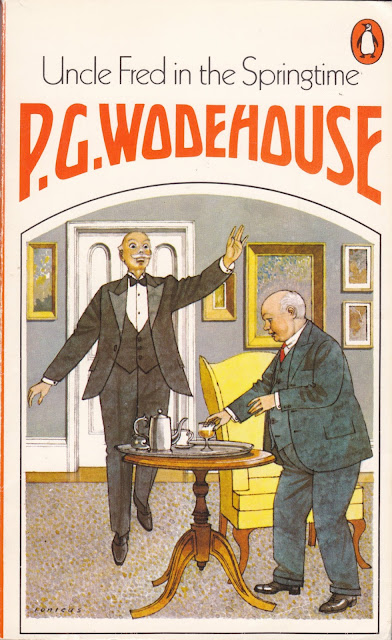I've been neglecting the Jeeves series of late, for some reason, so today let's redress the balance:
Stiff Upper Lip, Jeeves (1963) is in the lower-middle ranking of the Jeeves series, in my opinion; certainly not up there with
Right Ho, Jeeves or
The Code of the Woosters, and lesser even than the next rank which includes such beauties as
Thank You, Jeeves, but at the same time better than tired titles like
Jeeves in the Offing.
It has rather the feel of a retread of
The Code of the Woosters, featuring as it does Bertie paying a return visit to Totleigh Towers, including a reunion of most of that volume's cast of characters, though with variations on the old themes. Amongst the new elements is the introduction of Major Plank, first seen in the Uncle Fred novel
Uncle Dynamite (1948).
Nevertheless, despite this feeling of being presented with a reheated dish of mature ingredients, there is much to enjoy in the book, including some nice turns of phrase and a somewhat startling final twist to the long-running Gussie-Madeline saga.
The cover shows Bertie in something of a classic pose: it sometimes feels as if he spends half his life hiding behind sofas, under desks, and so on, though this is an illusion, I'm sure.
Jeeves has a more cherubic look than on other covers; he seems to have suffered a change of casting more often than any other character in the Ionicus pantheon. Madeline Bassett is more or less as one imagines Madeline Bassett. It is pleasing to note that even in these trying circumstances, Bertie's monocle remains firmly in place. In general, one of Ionicus's more successful efforts (though he has baulked at drawing a floor to stand on).
The book was first published in Penguin in 1966; the Ionicus cover dates from 1975. The text is set in Linotype Granjon, with a vaguely "contemporary" effect:
The attentive reader of this blog will remember, though the vapid and irreflective reader will have forgotten, that I have something of a soft spot for the last Jeeves novel, which is also the last novel Wodehouse completed,
Aunts Aren't Gentlemen (1974).
At 153 pages in the Penguin edition, it is by far the shortest of the Jeeves novels; it is probably a "novella" by the standards of the modern publishing industry. Set alongside the complications of
Right Ho, Jeeves, the plot seems like that of a slightly elaborated short story.
However, this is not really a defect. In some of the novels of the 1960s, Wodehouse seemed to be straining to maintain the old level of complication, but at the same time one could sense a weariness in the writing; plot twists towards the end of Act 2 sometimes have the air of duty about them. But in his very last books from the 1970s he seemed to recognise that it was a better strategy to simplify the plot a little, as this would allow himself to enjoy himself more.
In some of the preceding Jeeves novels, Wodehouse had allowed himself to slide almost into self-parody, with an over-reliance on tricks like saying "eggs and b." and applying to Jeeves to complete a quotation or find the right word. Indeed, I recall reading that Wodehouse had read a criticism of
Much Obliged, Jeeves (1971) which said as much, and he took this to heart when writing
Aunts Aren't Gentlemen. The extra care taken shows. This book, a series of variations on stealing a cat, is the last sweet song of a master, beautifully shaped, and with some really lovely moments: I heartily recommend to the reader the swimming pool scene, for example.
Some have objected to the introduction of a protest march into the plot, as being out of place. I don't agree personally; Wodehouse always made gestures towards modernity in his books (e.g. a little gag in the short story "Life With Freddie" about the firm of Beatle, Beatle, Beatle and Beatle of Liverpool) and it would be a very fastidious reader who cavilled at such stuff. The character of Orlo Porter is evidently meant as a sort of Communist Spode, and there are a few anti-Communist lines in there which to me don't really work because they show too obviously Wodehouse himself speaking. But for heaven's sake, do such tiny niggles matter? No, they do not.
The book appeared in Penguin in 1977, with the above Ionicus cover. The subdued colours are lovely and somehow quite appropriate. Ionicus has taken extra care, giving us every detail including an actual honest-to-goodness floor (stone flagged with a rug, appropriate to the rustic cottage that Bertie has taken to cure his spots on the chest). I would draw your attention to the cover's relation to Ionicus's earlier (1971) cover for
Carry On, Jeeves:
Just as, at the start of the saga, Jeeves had appeared mysteriously at the door to solve all Bertie's difficulties, so now, almost in mirror image, Jeeves stands at the door presenting the startled Bertie with a troublesome cat. The symmetry is surely deliberate.
(And was it also deliberate move by Wodehouse to end
Aunts Aren't Gentlemen in New York, on the run from an aunt, just as Bertie had decided to remain in New York at the end of the very first story, "Extricating Young Gussie", for the same reason?)
The typeface is Linotype Times, and it begins as follows:
Ah, you can keep your breathless opening lines, your "I knew at once he was dead" and "'Hands up!' snarled the man behind the gun" and "Last night I dreamt I went to Manderley again." If you can read the above and not want to read on, there is no hope for you.































